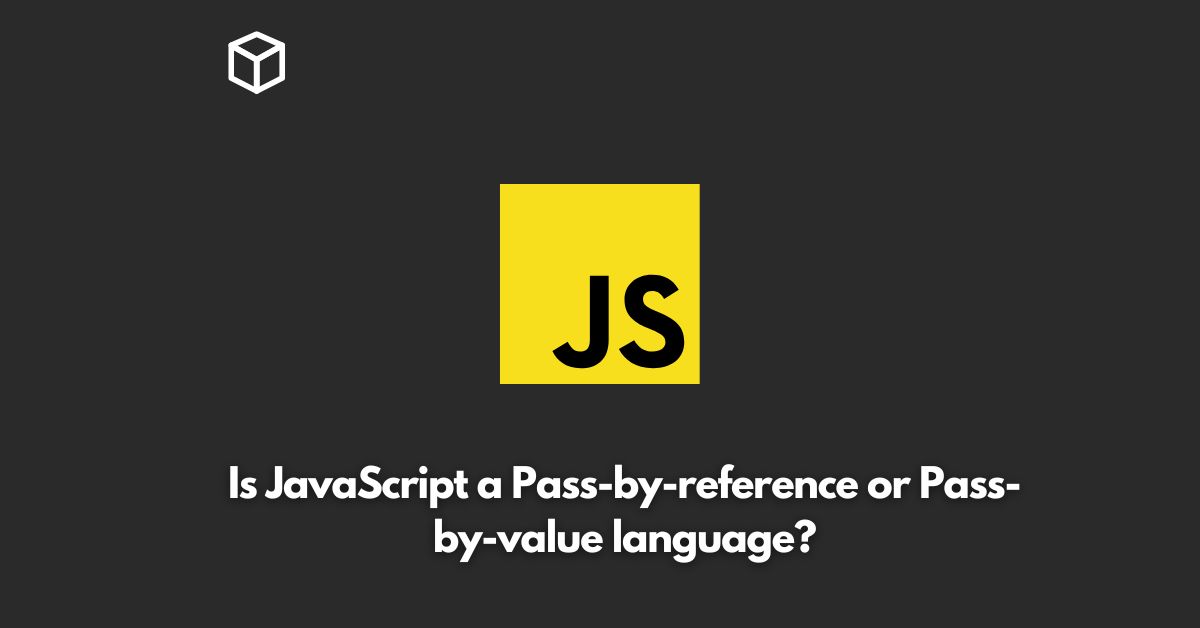JavaScript is a high-level, dynamic, and interpreted programming language that is widely used for developing web applications.
One of the most fundamental concepts in programming is the way in which values are passed between variables and functions.
There are two main ways in which this can be done, namely pass-by-reference and pass-by-value.
Pass-by-Reference in JavaScript
In pass-by-reference, the reference to an object is passed to a function.
The function can then modify the properties of the object, and these changes will be reflected outside of the function as well.
For example:
let obj = { name: 'John Doe' };
function updateName(objRef) {
objRef.name = 'Jane Doe';
}
updateName(obj);
console.log(obj.name); // Output: Jane DoeIn the example above, the updateName function takes in a reference to the obj object, which is passed by reference.
The function then updates the name property of the object, and the change is reflected outside of the function as well.
Pass-by-Value in JavaScript
In pass-by-value, a copy of the value is passed to the function.
The function can modify the value, but these changes will not be reflected outside of the function.
For example:
let name = 'John Doe';
function updateName(nameValue) {
nameValue = 'Jane Doe';
}
updateName(name);
console.log(name); // Output: John DoeIn the example above, the updateName function takes in a copy of the name variable, which is passed by value.
The function then updates the nameValue variable, but this change is not reflected outside of the function.
The value of the name variable remains unchanged.
JavaScript is Pass-by-Value for Primitive Data Types and Pass-by-Reference for Objects
It is important to note that in JavaScript, primitive data types such as numbers, strings, and booleans are passed by value, while objects and arrays are passed by reference.
This means that when a primitive data type is passed to a function, a copy of its value is passed, while when an object or array is passed to a function, a reference to the object is passed.
For example:
let num = 10;
let str = 'Hello, World!';
let bool = true;
let arr = [1, 2, 3];
let obj = { name: 'John Doe' };
function updateNum(numValue) {
numValue = 20;
}
function updateStr(strValue) {
strValue = 'Hello, Earth!';
}
function updateBool(boolValue) {
boolValue = false;
}
function updateArr(arrRef) {
arrRef[0] = 10;
}
function updateObj(objRef) {
objRef.name = 'Jane Doe';
}
updateNum(num);
updateStr(str);
updateBool(bool);
updateArr(arr);
updateObj(obj);
console.log(num); // Output: 10
console.log(str); // Output: Hello, World!
console.log(bool</code> ); // Output: true
console.log(arr); // Output: [10, 2, 3]
console.log(obj.name); // Output: Jane Doe
How to pass Primitive Data Types as References in JavaScript
Although primitive data types in JavaScript are passed by value, it is still possible to pass them as references by wrapping them in objects.
For example:
let num = 10;
let str = 'Hello, World!';
let bool = true;
let numWrapper = { value: num };
let strWrapper = { value: str };
let boolWrapper = { value: bool };
function updateNum(numWrapper) {
numWrapper.value = 20;
}
function updateStr(strWrapper) {
strWrapper.value = 'Hello, Earth!';
}
function updateBool(boolWrapper) {
boolWrapper.value = false;
}
updateNum(numWrapper);
updateStr(strWrapper);
updateBool(boolWrapper);
console.log(numWrapper.value); // Output: 20
console.log(strWrapper.value); // Output: Hello, Earth!
console.log(boolWrapper.value); // Output: falseIn the example above, the num, str, and bool variables are wrapped in objects and are passed as references to the respective updateNum, updateStr, and updateBool functions.
The changes made to the values of the numWrapper, strWrapper, and boolWrapper objects are reflected outside of the functions.
Final Thoughts
Pass-by-reference and pass-by-value are two important concepts in programming that are used to determine how values are passed between variables and functions.
In JavaScript, primitive data types are passed by value, while objects and arrays are passed by reference.
Understanding these concepts and how they are implemented in JavaScript is crucial for writing efficient and effective code.
Whether you are a beginner or an experienced programmer, it is always good to refresh your understanding of these concepts to help improve your skills and knowledge.
Conclusion
In conclusion, JavaScript is a mix of both pass-by-reference and pass-by-value, with primitive data types being passed by value and objects and arrays being passed by reference.
The distinction between pass-by-reference and pass-by-value can greatly impact how values are passed between variables and functions, so it’s important to understand these concepts to write efficient and effective code.
By wrapping primitive data types in objects, they can also be passed as references, making it possible to modify their values within functions.
With this knowledge, you should be well-equipped to write JavaScript code that effectively handles both pass-by-reference and pass-by-value.
Remember, practice makes perfect, so continue to experiment and practice using these concepts in your own code.




